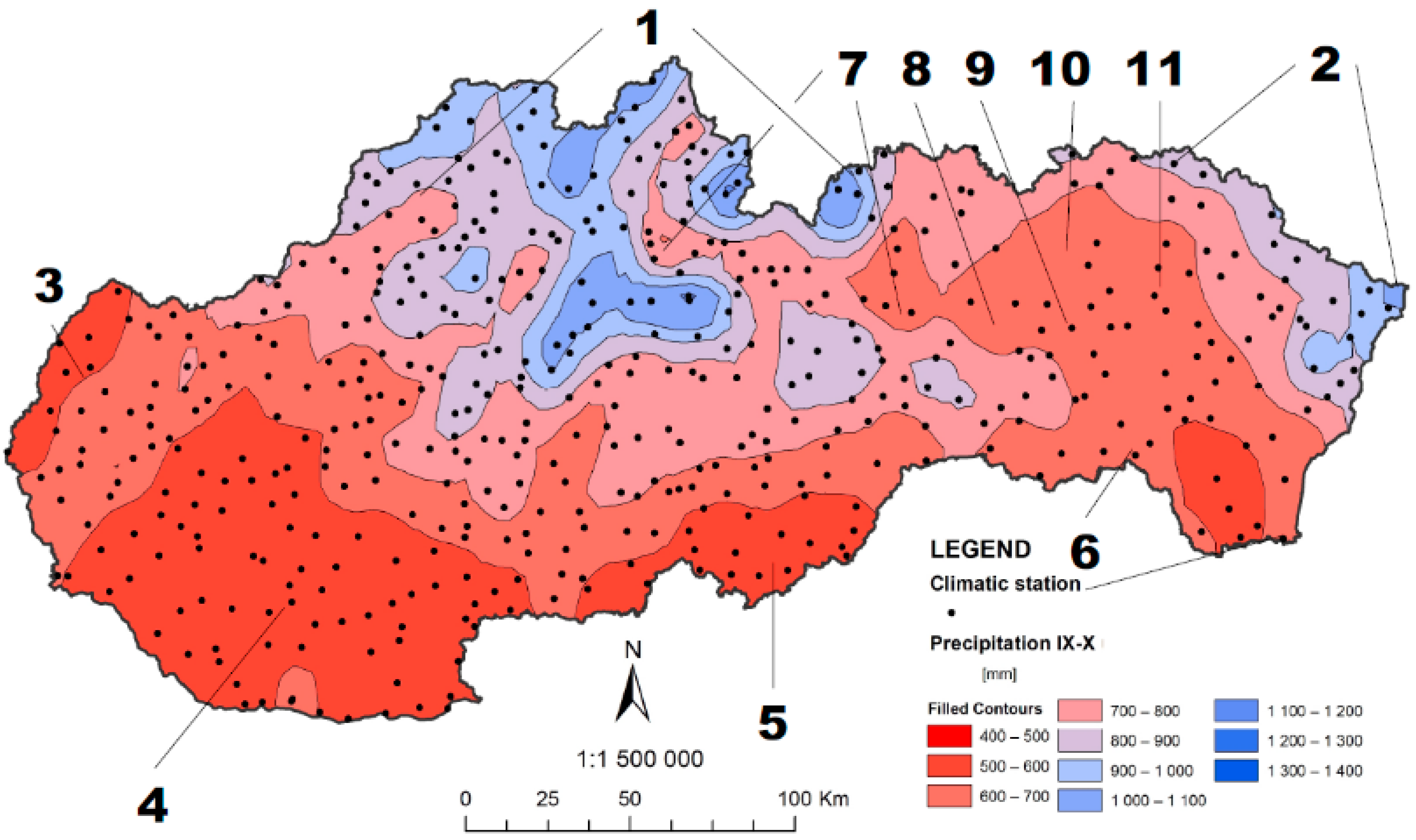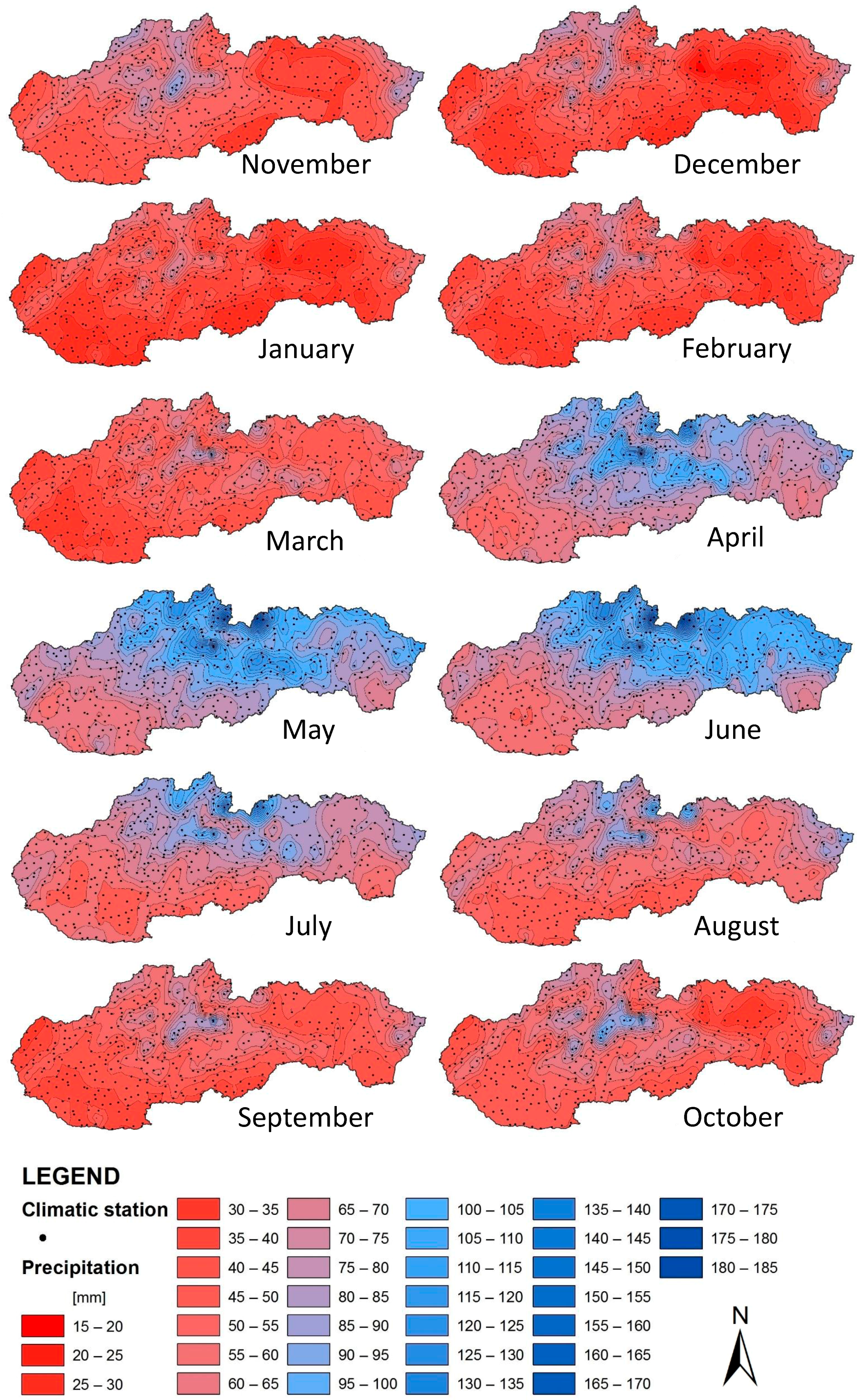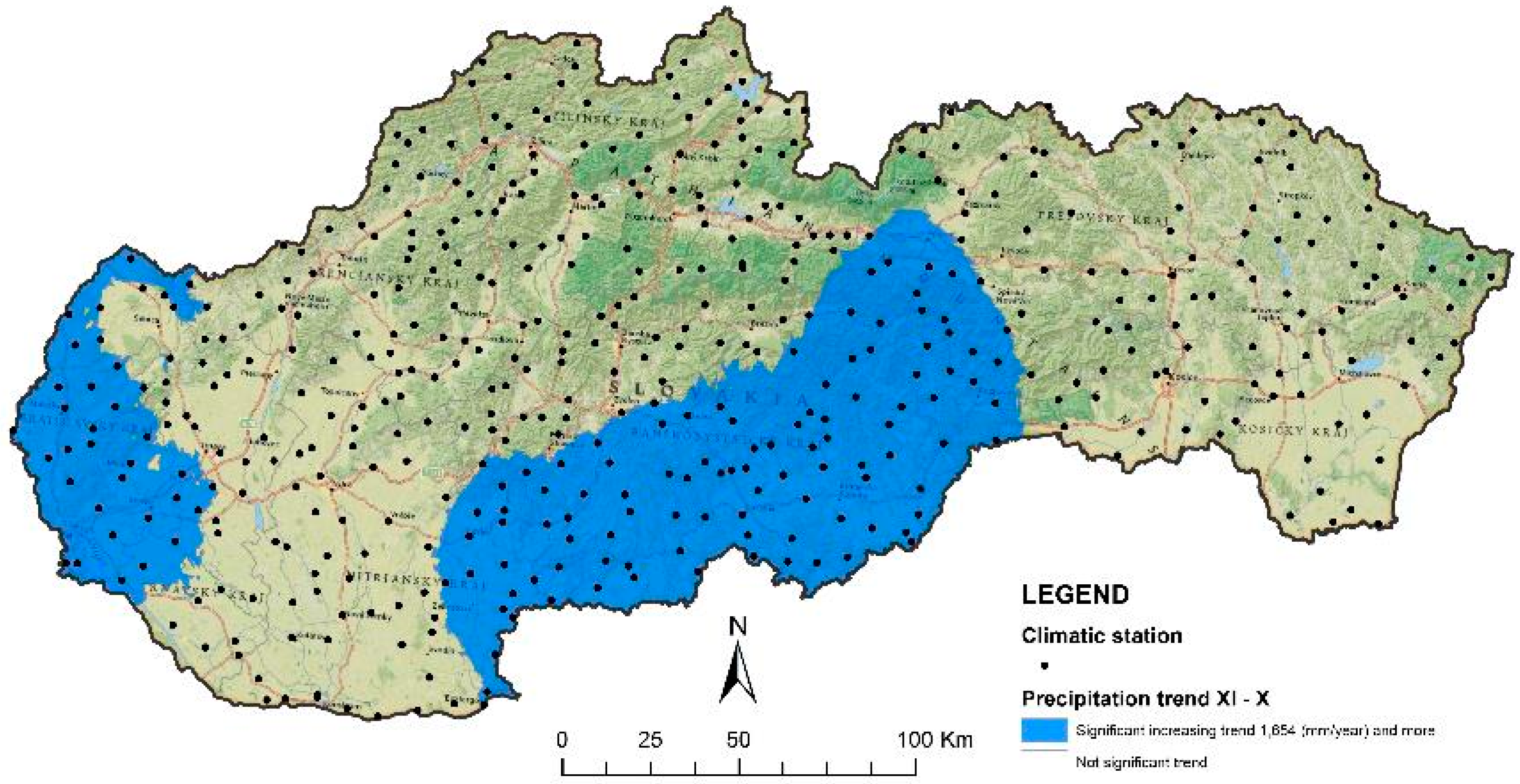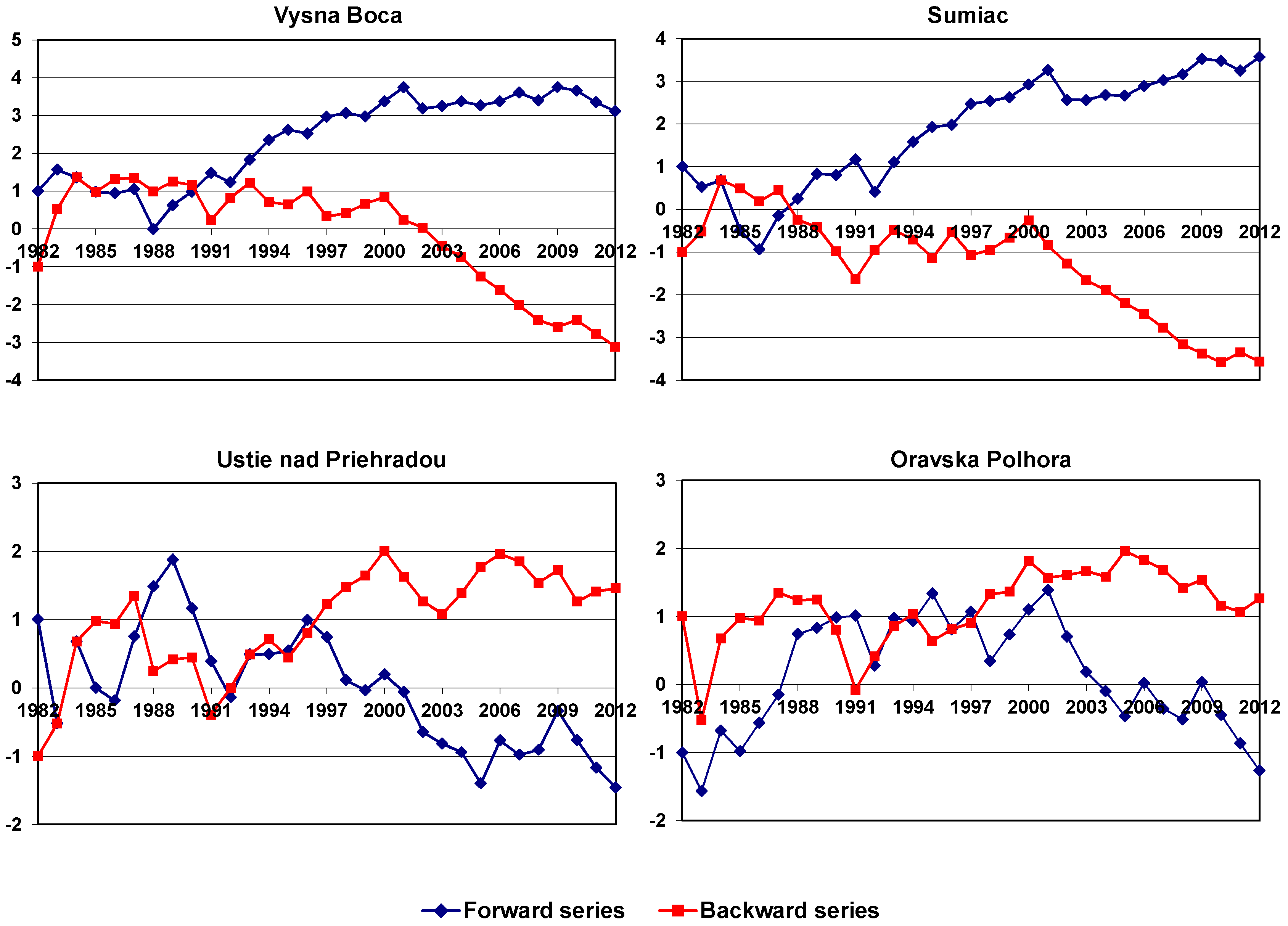Precipitation Trends over Slovakia in the Period 1981–2013
Abstract
:1. Introduction
2. Materials and Methods
2.1. Study Area and Data
2.2. Statistical Analysis
3. Results
3.1. Temporal and Spatial Precipitation Distribution over Slovakia in the Period 1981–2013
3.2. Annual, Seasonal, and Monthly Precipitation Trends
3.3. Abrupt Shifts in Precipitation
4. Discussion
5. Conclusions
Acknowledgments
Author Contributions
Conflicts of Interest
References
- Jones, J.R.; Schwartz, J.S.; Ellis, K.N.; Hathaway, J.M.; Jawdy, C.M. Temporal variability of precipitation in the Upper Tennessee Valley. J. Hydrol. Reg. Stud. 2015, 3, 125–138. [Google Scholar] [CrossRef]
- Villafuerte, M.Q., II; Matsumoto, J.; Akasaka, I.; Takahashi, H.G.; Kubota, H.; Cinco, T.A. Long-term trends and variability of rainfall extremes in the Philippines. Atmos. Res. 2014, 137, 1–13. [Google Scholar] [CrossRef]
- Karpouzos, D.K.; Kavalieratou, S.; Babajimopoulos, C. Trend analysis of precipitation data in Pieria region (Greece). Eur. Water 2010, 30, 31–40. [Google Scholar]
- Marszelewski, W.; Pius, B. The impact of changes in air temperature upon the thermal regime of the river Vistula in Toruń (Poland) over the years 1961–2012. In Proceedings of the 2nd International Conference Water Resources and Wetlands, Tulcea, Romania, 11–13 September 2014; Gâştescu, P., Marszelewski, W., Bretcan, P., Eds.; Romanian Limnogeographical Association: Dambovita, Romania, 2014; pp. 231–236. [Google Scholar]
- Wójcik, K.M.; Turczyński, M.; Sposób, J. Natural and anthropogenic changes of standing water bodies in West Polesie (east Poland). In Proceedings of the 2nd International Conference Water Resources and Wetlands, Tulcea, Romania, 11–13 September 2014; Gâştescu, P., Marszelewski, W., Bretcan, P., Eds.; Romanian Limnogeographical Association: Dambovita, Romania, 2014; pp. 36–43. [Google Scholar]
- Marszelewski, W.; Pius, B. Long-term changes in temperature of river waters in the transitional zone of the temperate climate: A case study of Polish rivers. Hydrol. Sci. J. 2016, 61, 1430–1442. [Google Scholar] [CrossRef]
- Poornima, U.; Jothiprakash, V. Extraction of Trend of Rainfall Using Singular Spectrum Analysis. J. Hydrol. Eng. 2015, 20, 05015007. [Google Scholar]
- Jothiprakash, V.; Fathima, T.A. Chaotic Analysis of Daily Rainfall Series in Koyna Reservoir Catchment Area. Stoch. Environ. Res. Risk A 2013, 27, 1371–1381. [Google Scholar] [CrossRef]
- Zeleňáková, M.; Purcz, P.; Blišťan, P.; Alkhalaf, I.; Hlavatá, H.; Portela, M.M.; Silva, A.T. Precipitation trends detection as a tool for integrated water resources management in Slovakia. Desalin. Water Treat. 2017, 1–8. [Google Scholar] [CrossRef]
- Maraun, D.; Wetterhall, F.; Ireson, A.M.; Chandler, R.E.; Kendon, E.J.; Widmann, M.; Brienen, S.; Rust, H.W.; Sauret, T.; Themeβl, M.; et al. Precipitation downscaling under climate change: Recent developments to bridge the gap between dynamical models and the end user. Rev. Geophys. 2010, 48, RG3003. [Google Scholar] [CrossRef]
- Trenberth, K. Changes in precipitation with climate change. Clim. Res. 2011, 47, 123–138. [Google Scholar] [CrossRef]
- Gizaw, M.S.; Gan, T.Y. Impact of climate change and El Niño episodes on droughts in sub-Saharan Africa. Clim. Dynam. 2017, 49, 665–682. [Google Scholar] [CrossRef]
- Lupikasza, E. Spatial and temporal variability of extreme precipitation in Poland in the period 1951–2006. Int. J. Climatol. 2010, 30, 991–1007. [Google Scholar] [CrossRef]
- Small, D.; Islam, S.; Vogel, R.M. Trends in precipitation and streamflow in the eastern US: Paradox or perception? Geophys. Res. Lett. 2006, 33. [Google Scholar] [CrossRef]
- Karl, T.R.; Knight, R.W. Secular trends of precipitation amount, frequency, and intensity in the United States. Bull. Am. Meteorol. Soc. 1998, 79, 231–241. [Google Scholar] [CrossRef]
- Keim, B.D.; Fischer, M.R. Are there spurious precipitation trends in the United States Climate Division database? Geophys. Res. Lett. 2005, 32. [Google Scholar] [CrossRef]
- Solomon, S.; Qin, D.; Manning, M.; Marquis, M.; Averyt, K.; Tignor, M.; Miller, H.; Chen, Z. Climate Change 2007: The Physical Science Basis; Working Group I, Fourth Assessment Report of the Intergovernmental Panel on Climate Change (IPCC); Cambridge University Press: London, UK, 2008. [Google Scholar]
- Gao, Y.; Fu, J.; Drake, J.; Liu, Y.; Lamarque, J. Projected changes of extreme weather events in the eastern United States based on a high resolution climate modeling system. Environ. Res. Lett. 2012, 7, 1–12. [Google Scholar] [CrossRef]
- Boyles, P.R.; Raman, S. Analysis of climate trends in North Carolina (1949–1998). Environ. Int. 2003, 29, 263–275. [Google Scholar] [CrossRef]
- Sayemuzzaman, M.; Jha, M.K. Seasonal and annual precipitation time series trend analysis in North Carolina, United States. Atmos. Res. 2014, 137, 183–194. [Google Scholar] [CrossRef]
- Endo, N.; Matsumoto, J.; Lwin, T. Trends in precipitation extremes over Southeast Asia. SOLA 2009, 5, 168–171. [Google Scholar] [CrossRef]
- Mall, R.K.; Singh, R.; Gupta, A.; Srinivasan, G.; Rathore, L.S. Impact of climate change on indian agriculture: A review. Clim. Chang. 2006, 78, 445–478. [Google Scholar] [CrossRef]
- Jain, S.K.; Kumar, V.; Sahariad, M. Analysis of rainfall and temperature trends in northeast India. Int. J. Climatol. 2013, 33, 968–978. [Google Scholar] [CrossRef]
- Zeleňáková, M.; Purcz, P.; Gargar, I.A.K. Evaluation of hydrological series in Libya. In Proceedings of the SGEM 2013: 13th International Multidisciplinary Scientific Geoconference: Water Resources, Forest, Marine and Ocean Ecosystems, Albena, Bulgaria, 16–22 June 2013; STEF92 Technology Ltd.: Albena, Bulgaria, 2013; pp. 125–132. [Google Scholar]
- IPCC (Intergovernmental Panel for Climatic Change). Working Group II: Impacts, Adaptation and Vulnerability. Extreme High Temperature and Precipitation Events. 2012. Available online: http://www.ipcc.ch/ipccreports/tar/wg2/index.php?idp=625 (accessed on 15 May 2015).
- Chingombe, W.; Gutierrez, J.E.; Pedzisai, E.; Siziba, E. A study of hydrological trends and variability of Upper Mazowe catchment Zimbabwe. 2005. Available online: http://www.jsd-africa.com/Jsda/Spring2005/ArticlePDF/Arc_study%20of%20hydrological%20trends%20and%20variability%20of%20upper%20Mazowe%20Catchment_Zimbabwe.pdf (accessed on 11 November 2016).
- Pauling, A.; Paeth, H. On the variability of return periods of European winter precipitation extremes over the last five centuries. Clim. Past Discuss. 2006, 2, 157–189. [Google Scholar] [CrossRef]
- Lopez-Moreno, J.; Vicente-Serrano, S.; Gimeno, L.; Nieto, R. Stability of the seasonal distribution of precipitation in the Mediterranean region: Observations since 1950 and projections for the 21st century. Geophys. Res. Lett. 2009, 36, 10703. [Google Scholar] [CrossRef]
- Sousa, P.M.; Trigo, R.M.; Aizpurua, P.; Nieto, R.; Gimeno, L.; Garcia-Herrera, R. Trends and extremes of drought indices throughout the 20th century in the Mediterranean. Nat. Hazards Earth Syst. Sci. 2011, 11, 33–51. [Google Scholar] [CrossRef] [Green Version]
- Tomozeiu, R.; Busuioc, A.; Marletto, V.; Zinoni, F.; Cacciamani, C. Detection of changes in the summer precipitation time series of the region Emilia-Romagna, Italy. Theor. Appl. Climatol. 2000, 67, 193–200. [Google Scholar] [CrossRef]
- Buffoni, L.; Maugeri, M.; Nanni, T. Precipitation in Italy from 1833 to 1996. Theor. Appl. Climatol. 1999, 63, 33–40. [Google Scholar] [CrossRef]
- Arnone, E.; Pumo, D.; Viola, F.; Noto, L.V.; La Loggia, G. Rainfall statistics changes in Sicily. Hydrol. Earth Syst. Sci. 2013, 17, 2449–2458. [Google Scholar] [CrossRef] [Green Version]
- Cannarozzo, M.; Noto, L.V.; Viola, F. Spatial distribution of rainfall trends in Sicily (1921–2000). Phys. Chem. Earth 2006, 31, 1201–1211. [Google Scholar] [CrossRef]
- Lapin, M.; Damborská, I.; Melo, M. Downscaling of GCM outputs for precipitation time series in Slovakia. Met. J. 2001, 4, 29–40. [Google Scholar]
- Parajka, J.; Kohnová, S.; Merz, R.; Szolgay, J.; Hlavčová, K.; Blöschl, G. Comparative analysis of the seasonality of hydrological characteristics in Slovakia and Austria. Hydrol. Sci. J. 2009, 54, 456–473. [Google Scholar] [CrossRef]
- Gaál, L. Introduction of Lapin’s indices into the cluster analysis of maximum k-day precipitation totals in Slovakia. Met. J. 2005, 8, 85–94. [Google Scholar]
- Kriegerová, I.; Kohnová, S. Seasonality analysis of flood occurrence in mid-sized catchments in Slovakia. J. Hydrol. Hydromech. 2005, 53, 154–163. [Google Scholar]
- Kohnová, S.; Lapin, M.; Szolgay, J.; Gaál, L. Methodology for the selection of 10-day maximum precipitation totals and their statistical analysis in the upper Hron region. Contrib. Geophys. Geod. 2005, 35, 281–298. [Google Scholar]
- Szolgay, J.; Parajka, J.; Kohnová, S.; Hlavčová, K. Comparison of mapping approaches of design annual maximum daily precipitation. Atmos. Res. 2009, 92, 289–307. [Google Scholar] [CrossRef]
- Gaál, L.; Kyselý, J.; Szolgay, J. Region-of-influence approach to a frequency analysis of heavy precipitation in Slovakia. Hydrol. Earth Syst. Sci. 2008, 12, 825–839. [Google Scholar] [CrossRef]
- Zeleňáková, M.; Portela, M.M.; Purcz, P.; Blišťan, P.; Silva, A.T.; Hlavatá, H.; Santos, J.F. Seasonal and spatial investigation of trends in precipitation in Slovakia. Eur. Water 2015, 52, 35–42. [Google Scholar]
- Climate Atlas of Slovakia; Slovak Hydrometeorologic Institute: Banská Bystrica, Slovakia, 2015; 228p.
- Burn, D.H.; Hag Elnur, M.A. Detection of hydrologic trends and variability. J. Hydrol. 2002, 255, 107–122. [Google Scholar] [CrossRef]
- Portela, M.M.; Zeleňáková, M.; Santos, J.F.; Purcz, P.; Silva, A.T.; Hlavatá, H. Drought analysis in Slovakia: Regionalization, frequency analysis and precipitation thresholds. In Proceedings of the 8th International Conference on River Basin Management, La Coruna, Spain, 18–20 May 2015; Brebbia, C.A., Ed.; Wessex Institute: Ashurst, UK, 2015; pp. 3–14. [Google Scholar]
- Jha, M.K.; Singh, A.K. Trend analysis of extreme runoff events in major river basins of Peninsular Malaysia. Int. J. Water 2013, 7, 142–158. [Google Scholar] [CrossRef]
- Martinez, J.C.; Maleski, J.J.; Miller, F.M. Trends in precipitation and temperature in Florida, USA. J. Hydrol. 2012, 452–453, 259–281. [Google Scholar] [CrossRef]
- Modarres, R.; Silva, V.P.R. Rainfall trends in arid and semi-arid regions of Iran. J. Arid Environ. 2007, 70, 344–355. [Google Scholar] [CrossRef]
- Modarres, R.; Sarhadi, A. Rainfall trends analysis of Iran in the last half of the twentieth century. J. Geophys. Res. 2009, 114. [Google Scholar] [CrossRef]
- Sonali, P.; Nagesh, K.D. Review of trend detection methods and their application to detect temperature changes in India. J. Hydrol. 2013, 476, 212–227. [Google Scholar] [CrossRef]
- Tabari, H.; Talaee, P.H. Temporal variability of precipitation over Iran: 1966–2005. J. Hydrol. 2011, 396, 313–320. [Google Scholar] [CrossRef]
- Mann, H.B. Non-parametric tests against trend. Econometrica 1945, 13, 245–259. [Google Scholar] [CrossRef]
- Kendall, M.G. Rank Correlation Measures; Charles Griffin: London, UK, 1975. [Google Scholar]
- Gocic, M.; Trajkovic, S. Analysis of changes in meteorological variables using Mann-Kendall and Sen’s slope estimator statistical tests in Serbia. Glob. Planet Chang. 2013, 100, 172–182. [Google Scholar] [CrossRef]
- Hasanean, H.; Almazroui, M. Rainfall: Features and Variations over Saudi Arabia, a Review. Climate 2015, 3, 578–626. [Google Scholar] [CrossRef]
- Lettenmaier, D.P.; Wood, E.F.; Wallis, J.R. Hydro-climato-logical trends in the continental United States, 1948–88. J. Clim. 1994, 7, 586–607. [Google Scholar] [CrossRef]
- Partal, T.; Kahya, E. Trend analysis in Turkish precipitation data. Hydrol. Process. 2006, 20, 2011–2026. [Google Scholar] [CrossRef]
- Yue, S.; Hashino, M. Temperature trends in Japan: 1900–1990. Theor. Appl. Climatol. 2003, 75, 15–27. [Google Scholar]
- Some’e, B.S.; Ezani, A.; Tabari, H. Spatiotemporal trends and change point of precipitation in Iran. Atmos. Res. 2012, 113, 1–12. [Google Scholar]
- Yan, T.; Shen, Z.; Bai, J. Spatial and Temporal Changes in Temperature, Precipitation, and Streamflow in the Miyun Reservoir Basin of China. Water 2017, 9, 78. [Google Scholar] [CrossRef]
- Liu, Q.; Yang, Z.; Cui, B. Spatial and temporal variability of annual precipitation during 1961–2006 in Yellow River Basin, China. J. Hydrol. 2008, 361, 330–338. [Google Scholar] [CrossRef]
- Abdul Aziz, O.I.; Burn, D.H. Trends and variability in the hydrological regime of the Mackenzie River Basin. J. Hydrol. 2006, 319, 282–294. [Google Scholar] [CrossRef]
- Bayazit, M.; Önöz, B. To prewhiten or not to prewhiten in trend analysis? Hydrol. Sci. J. 2007, 52, 611–624. [Google Scholar] [CrossRef]
- Cunderlik, J.M.; Burn, D.H. Local and regional trends in monthly maximum flows in Southern British Columbia. Can. Water Resour. J. 2002, 27, 191–212. [Google Scholar] [CrossRef]
- Haktanir, T.; Citakoglu, H. Closure to “Trend, Independence, Stationarity, and Homogeneity Tests on Maximum Rainfall Series of Standard Durations Recorded in Turkey”. J. Hydrol. Eng. 2015, 20, 07015017. [Google Scholar] [CrossRef]
- Khaliq, M.N.; Ouarda, T.B.M.J.; Gachon, P.; Sushama, L.; St-Hilaire, A. Identification of hydrological trends in the presence of serial and cross correlations: A review of selected methods and their application to annual flow regimes of Canadian rivers. J. Hydrol. 2009, 368, 117–130. [Google Scholar] [CrossRef]
- Önöz, B.; Bayazit, M. The power of statistical tests for trend detection. Turkish J. Eng. Environ. Sci. 2003, 27, 247–251. [Google Scholar]
- Yue, S.; Wang, C.Y. Applicability of prewhitening to eliminate the influence of serial correlation on the Mann–Kendall test. Water Resour. Res. 2002, 38, 41–47. [Google Scholar] [CrossRef]
- Von Storch, H. Misuses of statistical analysis in climate research. In Analysis of Climate Variability Applications of Statistical Techniques; von Storch, H., Navarra, A., Eds.; Springer-Verlag: Berlin/Heidelberg, Germany, 1995; pp. 11–26. [Google Scholar]
- Sen, P.K. Estimates of the regression coefficient based on Kendall’s tau. J. Am. Stat. Assoc. 1968, 63, 1379–1389. [Google Scholar] [CrossRef]
- Theil, H. A rank-invariant method of linear and polynomial regression analysis, I, II, III. In Proceedings of Koninalijke Nederlandse Akademie van Weinenschatpen A; North-Holland Pub. Co.: Amsterdam, The Netherlands, 1950; Volume 53, pp. 1397–1412. [Google Scholar]
- Hirsch, R.M.; Slack, J.R.; Smith, R.A. Techniques of trend analysis for monthly water quality data. Water Resour. Res. 1982, 18, 107–121. [Google Scholar] [CrossRef]
- Jianqing, F.; Qiwei, Y. Nonlinear Time Series: Nonparametric and Parametric Methods, 1st ed.; Springer Series in Statistics; Springer: New York, NY, USA, 2003. [Google Scholar]
- Yue, S.; Pilon, P.; Phinney, B.; Cavadias, G. The influence of autocorrelation on the ability to detect trend in hydrological series. Hydrol. Process. 2002, 16, 1807–1829. [Google Scholar] [CrossRef]
- Bürger, G. On trend detection. Hydrol. Process. 2017, 31, 4039–4042. [Google Scholar] [CrossRef]
- Salas, J.D.; Delleur, J.W.; Yevjevich, V.; Lane, W.L. Applied Modelling of Hydrologic Time Series; Water Resources Publications: Littleton, CO, USA, 1980. [Google Scholar]
- Di Piazza, A.; Lo Conti, F.; Noto, L.V.; Viola, F.; La Loggia, G. Comparative analysis of different techniques for spatial interpolation of rainfall data to create a serially complete monthly time series of precipitation for Sicily, Italy. Int. J. Appl. Earth Obs. Geoinf. 2011, 13, 396–408. [Google Scholar] [CrossRef]
- Di Piazza, A.; Lo Conti, F.; Viola, F.; Eccel, E.; Noto, L.V. Comparative Analysis of Spatial Interpolation Methods in the Mediterranean Area: Application to Temperature in Sicily. Water 2015, 7, 1866–1888. [Google Scholar] [CrossRef] [Green Version]
- Trnka, M.; Balek, J.; Zahradníček, P.; Eitzinger, J.; Formayer, H.; Turňa, M.; Brázdil, R. Drought trends over part of Central Europe between 1961 and 2014. Clim. Res. 2016, 70, 143–160. [Google Scholar] [CrossRef]
- Brázdil, R.; Chromá, K.; Dobrovolný, P.; Tolasz, R. Climate fluctuations in the Czech Republic during the period 1961–2005. Int. J. Climatol. 2009, 29, 223–242. [Google Scholar] [CrossRef]
- Vido, J.; Tadesse, T.; Šustek, Z.; Kandrík, R.; Hanzelová, M.; Škvarenina, J.; Hayes, M. Drought occurrence in central european mountainous region (Tatra National Park, Slovakia) within the period 1961–2010. Adv. Meteorol. 2015, 2015. [Google Scholar] [CrossRef]
- Niedźwiedź, T.; Twardosz, R.; Walanus, A. Long-term variability of precipitation series in east central Europe in relation to circulation patterns. Theor. Appl. Climatol. 2009, 98, 337–350. [Google Scholar] [CrossRef]
- Lapin, M.; Faško, P. Precipitation and changes of the atmospheric circulation in the period 1874–1993 in Slovakia. Meteorologické Zprávy 1996, 49, 1–11. [Google Scholar]
- Hanna, E.; Cropper, T.E.; Jones, P.D.; Scaife, A.A.; Allan, R. Recent seasonal asymmetric changes in the NAO (a marked summer decline and increased winter variability) and associated changes in the AO and Greenland Blocking Index. Int. J. Climatol. 2015, 35, 2540–2554. [Google Scholar] [CrossRef]
- Labudová, L.; Šťastný, P.; Trizna, M. The north atlantic oscillation and winter precipitation totals in Slovakia. Morav. Geogr. Rep. 2013, 21, 38–49. [Google Scholar]
- Labudová, L.; Faško, P.; Ivaňáková, G. Changes in climate and changing climate regions in Slovakia. Morav. Geogr. Rep. 2015, 23, 71–82. [Google Scholar] [CrossRef]
- Radinović, D.; Ćurić, M. Some evidence on European monsoon existence. Theor. Appl. Climatol. 2012, 110, 11–15. [Google Scholar] [CrossRef]
- Konček, M. Klima Tatier (Climate of Tatry Mountains); Vyd. Slovenskej Akad. Vied: Bratislava, Slovakia, 1974. (In Slovak) [Google Scholar]
- Lin, Z.; Lu, R. Impact of summer rainfall over southern-central Europe on circumglobal teleconnection. Atmos. Sci. Lett. 2016, 17, 258–262. [Google Scholar] [CrossRef]
- Lapin, M.; Gera, M.; HrvoĽ, J.; Melo, M.; Tomlain, J. Possible impacts of climate change on hydrologic cycle in Slovakia and results of observations in 1951–2007. Biologia 2009, 64, 454–459. [Google Scholar] [CrossRef]
- Škvarenina, J.; Krizova, E.; Tomlain, J.N. Impact of the climate change on the water balance of altitudinal vegetation stages in Slovakia. Ekol. Bratisl. 2004, 23, 13–29. [Google Scholar]
- Müller, M.; Kašpar, M.; Matschullat, J. Heavy rains and extreme rainfall-runoff events in Central Europe from 1951 to 2002. Nat. Hazard. Earth Syst. 2009, 9, 441–450. [Google Scholar] [CrossRef]
- Faško, P.; Lapin, M.; Šťastný, P.; Vivoda, J. Maximum daily sums of precipitation in Slovakia in the second half of the 20th century. Prace Geogr. Zesz. 2000, 108, 131–138. [Google Scholar]
- Halmova, D.; Pekarova, P.; Olbrimek, J.; Miklanek, P.; Pekar, J. Precipitation regime and temporal changes in the Central Danubian lowland region. Adv. Meteorol. 2015, 2015, 1–12. [Google Scholar] [CrossRef]
- Niedźwiedź, T. Changes of atmospheric circulation (using the P, S, C, M indices) in the winter season and their influence on air temperature in Cracow. Early Meteorological Instrumental Records in Europe—Methods and Results. Zeszity Naukowe UJ Prace Geogr. 1993, 95, 107–113. [Google Scholar]
- Pekárová, P.; Pramuk, B.; Halmová, D.; Miklánek, P.; Prohaska, S.; Pekár, J. Identification of long-term high-flow regime changes in selected stations along the Danube River. J. Hydrol. Hydromech. 2016, 64, 393–403. [Google Scholar] [CrossRef]
- Fendeková, M.; Pekárová, P.; Fendek, M.; Pekár, J.; Škoda, P. Global drivers effect in multi-annual variability of runoff. J. Hydrol. Hydromech. 2014, 62, 169–176. [Google Scholar] [CrossRef]







| Precipitation | Mean | Median | 95 Percentile | 5 Percentile |
|---|---|---|---|---|
| Annual | 720.2 | 692.7 | 1074.7 | 504.4 |
| Winter | 142.4 | 138.2 | 259.5 | 101.5 |
| Spring | 125.6 | 123.6 | 231.9 | 97.7 |
| Summer | 238.2 | 233.6 | 416.9 | 176.0 |
| Autumn | 173.0 | 168.5 | 319.7 | 138.4 |
| November | 54.8 | 48.7 | 116.8 | 37.0 |
| December | 52.1 | 46.0 | 117.2 | 35.2 |
| January | 44.1 | 39.6 | 99.4 | 26.9 |
| February | 39.8 | 37.1 | 86.0 | 27.4 |
| March | 44.6 | 37.4 | 103.4 | 30.8 |
| April | 48.8 | 43.6 | 105.9 | 34.6 |
| May | 78.9 | 70.0 | 163.8 | 56.7 |
| June | 87.6 | 82.8 | 159.9 | 60.4 |
| July | 86.2 | 76.8 | 189.6 | 56.8 |
| August | 70.7 | 62.3 | 156.9 | 53.3 |
| September | 62.0 | 52.2 | 145.9 | 45.0 |
| October | 50.7 | 41.9 | 120.0 | 37.3 |
| Precipitation | Number of Significant Decreasing Trends | Number of Significant Increasing Trends | % of Significant Trends | Number of Stations with No Trends |
|---|---|---|---|---|
| Annual | 2 | 155 | 32 | 330 |
| Winter | 3 | 68 | 15 | 416 |
| Spring | 1 | 20 | 4 | 466 |
| Summer | 0 | 123 | 25 | 364 |
| Autumn | 0 | 1 | 0 | 486 |
| November | 0 | 1 | 0 | 486 |
| December | 15 | 36 | 10 | 436 |
| January | 0 | 105 | 22 | 382 |
| February | 0 | 26 | 5 | 461 |
| March | 0 | 13 | 3 | 474 |
| April | 3 | 0 | 1 | 484 |
| May | 2 | 0 | 0 | 485 |
| June | 1 | 48 | 10 | 438 |
| July | 0 | 245 | 50 | 242 |
| August | 3 | 1 | 1 | 483 |
| September | 0 | 0 | 0 | 487 |
| October | 0 | 2 | 0 | 485 |
© 2017 by the authors. Licensee MDPI, Basel, Switzerland. This article is an open access article distributed under the terms and conditions of the Creative Commons Attribution (CC BY) license (http://creativecommons.org/licenses/by/4.0/).
Share and Cite
Zeleňáková, M.; Vido, J.; Portela, M.M.; Purcz, P.; Blištán, P.; Hlavatá, H.; Hluštík, P. Precipitation Trends over Slovakia in the Period 1981–2013. Water 2017, 9, 922. https://doi.org/10.3390/w9120922
Zeleňáková M, Vido J, Portela MM, Purcz P, Blištán P, Hlavatá H, Hluštík P. Precipitation Trends over Slovakia in the Period 1981–2013. Water. 2017; 9(12):922. https://doi.org/10.3390/w9120922
Chicago/Turabian StyleZeleňáková, Martina, Jaroslav Vido, Maria Manuela Portela, Pavol Purcz, Peter Blištán, Helena Hlavatá, and Petr Hluštík. 2017. "Precipitation Trends over Slovakia in the Period 1981–2013" Water 9, no. 12: 922. https://doi.org/10.3390/w9120922






